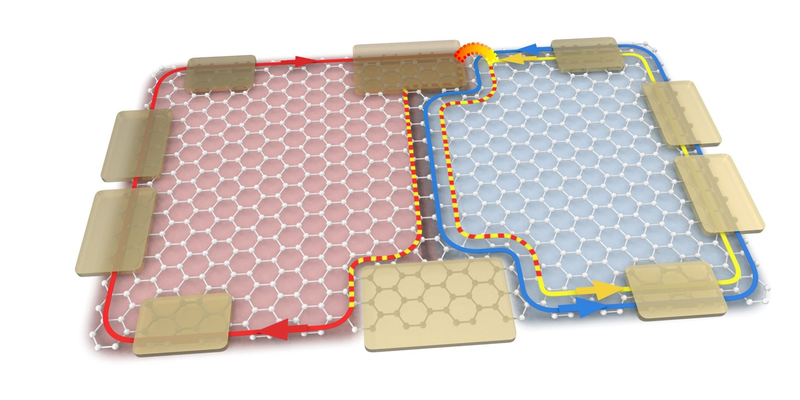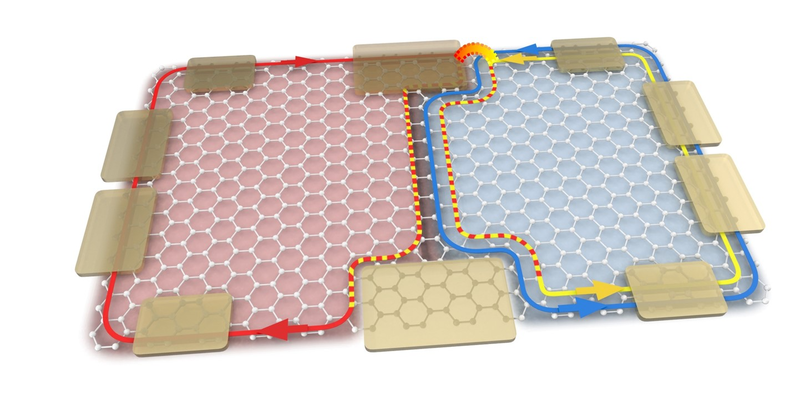Optics Bench on a Graphene Flake
Optical interferometers use the wave nature of light to make measurements with extremely high accuracy. Researchers have also created interferometers that exploit the wave nature of electrons, including some that use graphene, a single-atom-thick sheet of carbon that allows electron waves to propagate with little disruption from environmental noise. Now a team has demonstrated a fully adjustable electron interferometer on graphene [1]. Researchers expect the device to be useful for some types of quantum computers.
An optical interferometer splits a light beam into two beams, sends those beams along different paths, and then recombines them to create interference effects that reveal any subtle differences between the two paths of the beams. Interferometers for electrons will be useful for quantum computers whose quantum bits involve electrons in specific quantum states in 2D nanoscale devices. Performing logic operations on these bits can be accomplished with interferometers.
The beam splitter is a critical piece of an interferometer. Graphene-based electron beam splitters in the past have not provided full control over the amplitudes of the two output beams, which would allow researchers more flexibility in designing interferometers for specific purposes. Spurred by a new understanding of certain electron tunneling effects in graphene, Preden Roulleau of Paris-Saclay University and colleagues set out to build a beam splitter capable of this higher level of control and then to put it into an interferometer.
The researchers applied voltages above, below, and around the edges of a graphene flake to create two adjacent regions with different electrical properties. Turning on an intense magnetic field and sending electric current through the flake led to currents circulating in opposite directions around the edges of the two regions. Electrons in these so-called edge states behave much like coherent beams of light forced to travel in loops. “These channels act like optical fibers, only for electrons,” Roulleau says.
A single spin-up electron current circulated clockwise around the left-hand region, and two electron currents—one spin-up and one spin-down—circulated counterclockwise around the right-hand region. To create a beam splitter, the researchers focused on the boundary between the two regions, where spin-up electrons from both circuits could travel in parallel along each side of the boundary. As electrons on the right side approached the boundary, they could either remain on their side of the divide or tunnel across to the left-hand region. Using an applied voltage, the team could control this tunneling effect and thus determine the fraction of current moving along each side of the boundary, just as a tunable optical beam splitter divides a light beam into portions traveling along two different paths. Tests showed that this electron beam splitter provided very precise control.
Next, the researchers applied a second voltage at the other end of the boundary, thereby inducing a “reverse” beam splitter capable of merging the two currents. Using both beam splitters, they demonstrated the operation of an interferometer. By varying the strength of the magnetic field or the voltage applied at the first beam splitter, they observed interference fringes—oscillatory variations in the electron current output—as expected for an interferometer.
“These experiments demonstrate a really fundamental component in the electron quantum optics toolbox,” says Peter Samuelsson of Lund University in Sweden, who studies mesoscopic physics. “This opens up new prospects for precise control of electron behavior.”
In addition to the tunable beam-splitter, the technique also allows an interferometer to be further miniaturized, says Roulleau. “We hope this will open a new field of experiments with extremely compact interferometers, which would not be possible with other standard approaches,” he says. For example, an important step toward quantum computation would be to demonstrate so-called “flying qubits,” in which electrons carrying quantum information can be made to perform computations while in free flight. Such a demonstration would require very small interferometers, says Roulleau.
Correction (13 April 2021): An earlier version contained an incorrect affiliation for Preden Roulleau.
–Mark Buchanan
Mark Buchanan is a freelance science writer who splits his time between Abergavenny, UK, and Notre Dame de Courson, France.
References
- M. Jo et al., “Quantum Hall valley splitters and a tunable Mach-Zehnder interferometer in graphene,” Phys. Rev. Lett. 126, 146803 (2021).





